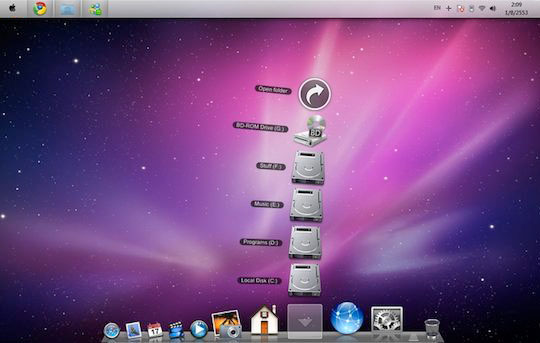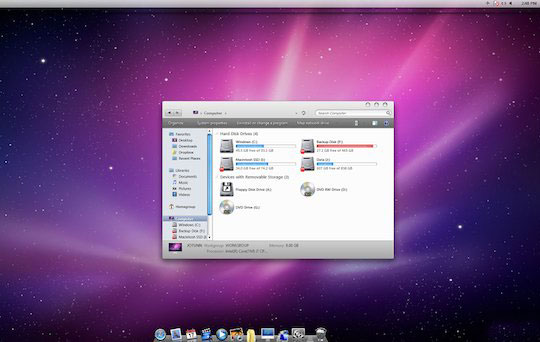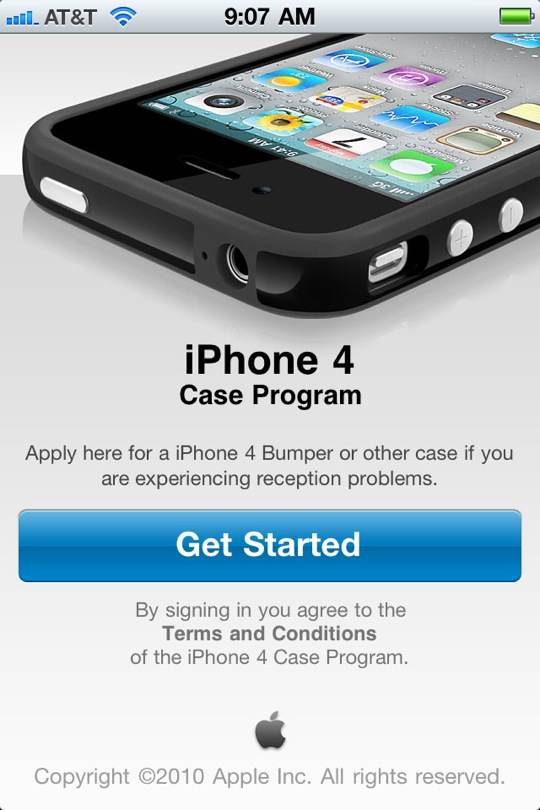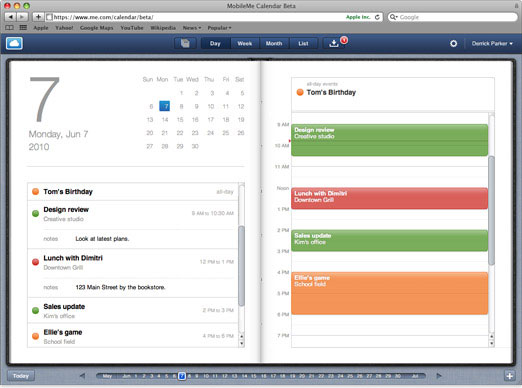Mac Theme for Windows 7

If you’re using a Windows 7 machine, why not make it look like Mac OS X? This task is made very easy with a theme/skin set called the Snow Transformation Pack, it turns your Windows 7 theme into a very convincing near complete Mac OS X interface including icons, wallpapers, the Dock, sounds, dialogue boxes, login screen, window skin, and more.
The Snow Transformation pack is freeware and available to download here
Of course if you’re this obsessed with Mac OS, you should probably just buy a Mac and save yourself from the burden of Windows 7 and trying to skin it to look like a Mac, right?

Apple seeds first Mac OS X 10.6.5 build to developers
Developers report Apple has just made available the first build of what will ship as the free Mac OS X 10.6.5 update later this fall.
The new uild, numbered 10H525, incorporates solutions to existing problems with Exchange Server support, fixes user interface issues with embedded WebKit views in applications such as iTunes, and includes the graphics drivers in the earlier Snow Leopard Graphics Update release.
Apple is asking developers in particular to test iCal, Mail, printing, OpenGL 3D Graphics, QuickTime and the X Window X11 subsystems.
The current release of Mac OS X was last updated in June following WWDC. The initial developer build of 10.6.5 was anticipated to ship nearly a month ago in late July, but has continued to slip as Apple continues to focus its efforts on NVIDIA graphics drivers and related issues.
SproutCore founder leaves Apple to pursue new HTML5 iPad apps
As promised, Apple on Friday launched its iPhone 4 Case Program, granting free cases to customers who buy a phone through Sept. 30, and refunding those who already bought a protective "bumper" through an iPhone application.The website with instructions is available at apple.com/iphone/case-program/, but users must request their case through the free "iPhone 4 Case Program" application on the App Store. From there, users sign in with their iTunes Store account or Apple ID, and can choose a bumper case.
iPhone 4 customers who made a purchase before July 23 must apply no later than Aug. 22, 2010. Otherwise, customers must apply within 30 days of their iPhone 4 purchase. To qualify for the program, customers must purchase their iPhone 4 by Sept. 30, 2010.
"If you are experiencing reception issues with your iPhone 4, youa re eligible to receive an iPhone 4 Bumper or other select third-party case from Apple at no charge," the application’s description reads. "Download this ree app onto your iPhone 4 and apply your free bumper or case."
"Only iPhone 4 owners are eligible for this program. The app will check the IMEI and serial number to verify that you have an iPhone 4. Once eligibility is confirmed, you will be able to choose an iPhone 4 bumper or other case. The bumper or case will be shipped to you at no charge."
Options include a black first-party bumper, smoke or clear Incase Snap Cases, clear Belkin Shield Micra, diamonds/smoke Griffin Motif, black/black graphite Griffin Reveal Etch, black tartan Speck Fitted Case, and black Speck PixelSkin HD. All of the cases ship within 3 to 5 weeks.

Apple also said that those who purchased a bumper via credit card have already been refunded automatically. Those refunds began Thursday. Apple Retail Store customers can check the status of their refund at iphonebumper.apple.com.
Those who bought with cash, check or gift card at an Apple Store must return to the store with their receipt by Sept. 30, 2010 to get their refund. Customers who used a gift card on the Apple Online Store will be automatically mailed a new gift card for the refund amount.
Finally, for those who bought through an AT&T store, customers will be reimbursed for the purchase price as well. A rebate coupon is available to fill out on Apple’s website. The rebate form must be mailed by Sept. 30, 2010, and refunds will be sent as soon as the claim is processed.
Apple’s case program site also includes information on how customers can return their handset if they are not fully satisfied.
"You can return your undamaged iPhone 4 to any Apple Retail Store or the Apple Online Store within 30 days of purchase for a full refund," the site reads. "If you purchased your iPhone 4 from AT&T, you can also return it to an AT&T store."
The page also includes a link to Apple’s newly launched antenna performance site, which explains the attenuation effect that can be experienced on the iPhone 4 and other smartphones when held improperly. Apple explained the issue and launched the site last week at its iPhone 4 press conference, when the company also revealed its free bumpers and cases program.
SproutCore founder leaves Apple to pursue new HTML5 iPad apps
Apple’s revised 27" iMac introduced this spring debuted a new feature: a Mini DisplayPort video port that worked in both directions, enabling external video sources to output video to the screen. That feature is largely limited to 720p in HDTV applications however.
Excitement about the potential for using the iMac and its large, high quality display as an HDMI HDTV or display for a game console such as the Xbox or PlayStation 3 fizzled after it was revealed that the port only supports DisplayPort input signals, and not the VGA or DVI/HDMI video signals that most external devices use.
This limitation effectively limits the iMac to accepting video input from recent MacBooks or other computers that produce DisplayPort video, which works significantly differently from earlier analog VGA or digital formats such as DVI/HDMI.
That technical chasm can be bridged by a converter box that accepts a DVI/HDMI signal (the two video standards are essentially the same in different packaging), transforms it to DisplayPort signaling, and scales it to the output resolution of the iMac.
A simple physical adapter won’t work for video input due to the iMac’s DisplayPort-only input limitation; cheap Mini DisplayPort-to-HDMI adapters can only extract the HDMI output signal the iMac generates and pushes through its Mini DisplayPort connector. They do not do any signal translation.
Two products that can do this translation work are the AV360™ Mini DisplayPort Converter and Kanex HD, both of which cost $150. However, while those products appear to be capable of generating both 720p and 1080p output, the 27" iMac only accepts 720p video or its native 2560x1440 resolution.
EDID limitation
It appears the 27" iMac could accept 1080p input, and certainly can support display of the video resolution, as it falls well within its 2560x1440 native resolution. A similar problem affects Apple’s 24" LED Cinema Display, which has a native 1920x1200 resolution but only supports that resolution via its DisplayPort input; like the 27" iMac, it won’t accept a 1080p signal (1920x1080), the common format of higher end HD equipment such as HDMI set top boxes and the PS3, even though it appears it should be able to.
The problem is that Apple’s EDID (Extended Display Identification Data) on the iMac and LED Cinema Display doesn’t advertise 1080p as an option. EDID is a simple data structure a display sends to output devices that outlines what video formats and settings it knows how to support. Both devices appear capable of 1080p but simply don’t advertise that capability in a way that external devices like the AV360 and Kanex HD can take advantage of.
It appears Apple could update the firmware for these displays to enable support of 1080p input, allowing users to input full 1080p video from devices such as the PS3. Users might not notice a major difference, as experts say its hard to see a real difference between 720p and 1080p on screens smaller than 50 inches.
However, some devices are hardwired to only support 1080p, and can’t scale their output to support the Cinema Display’s slightly higher resolution nor the 27" iMacs much higher resolution, forcing them to downscale to 720p or not work at all (as is the case with the LED Cinema Display, which is really only indended to work with Apple’s Mini DisplayPort-equipped MacBooks and modern desktop Macs).
SproutCore founder leaves Apple to pursue new HTML5 iPad apps
Charles Jolley, the developer behind SproutCore, has left Apple to start Strobe Inc., a new business targeting touch-driven web applications. Both Apple and Strobe will continue to advance SproutCore as a core asset.
SproutCore is an open source, platform-independent, Cocoa-inspired JavaScript framework for creating web applications that look and feel like Desktop applications.
Apple discovered Jolley’s SproutCore startup and hired him to create the MobileMe suite of web apps, beginning with a new Gallery web app for .Mac in the fall of 2007. In 2008, Apple relaunched .Mac as MobileMe, and introduced a full suite of web apps built using SproutCore.
The following year, Apple released iWork.com, which also uses SproutCore. This year, the company began introducing refreshed "V2" versions of the MobileMe components apps, starting with the iPad-inspired new look of Mail, and continuing with the latest announcement of a new MobileMe Calendar app, now in beta.
The MobileMe Calendar app (below) will be Jolley’s final project at Apple. While Apple’s MobileMe team continues to enhance its online offerings, Jolley’s new Strobe startup will focus on the emerging market for web apps.
"Strobe Inc. is about building marrying the web and touch, where you get the best of both worlds: easy access to your data from any device (like the web), with a rich immersive interface (like native touch)," Jolley wrote in an email interview with AppleInsider.

"SproutCore is very good at supporting just these types of apps; it will be at the center of everything we do. Strobe will be investing quite heavily in it," Jolley said.
The SproutCore development community
Asked about the kind of support SproutCore is seeing as an open software project, Jolly wrote, "the SproutCore open source community is very healthy. We have about 1,500 people on our mailing list and a very active IRC channel. We also have 33 regular contributors to SproutCore, 75% not from Apple.
"I’ve always been more interested in influence over numbers with SproutCore. We tend to have key teams working on high profile projects at well known companies vs having a lot of tinkerers. Mozilla, for example, uses parts of it for their Bespin project. Gomez based parts of their products on it. There are a few other well known enterprise companies that are literally rewriting their entire product based on it. Total bet-the-company type of moves.
"All of the customers interested in Strobe’s SproutCore-based solution are household names in publishing. We are going to have even more big name support going forward," Jolley said.
Inside Apple’s new Xcode 4 development tool
At WWDC, Apple treated its Mac OS X and iOS programmers to a preview of its entirely revised Xcode 4 integrated development environment. Here’s a look at what’s new and how it matters for end users.
Xcode 4 presents an entirely new user interface and workflow for developers, along with new components for compiling, debugging and finding and correcting common errors. The result: better, faster code from more productive developers.